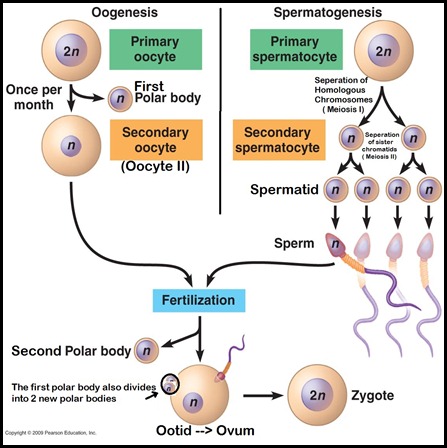Steps Involved In Gamete Formation

The Steps Involved in Creating Copies of Deoxyribonucleic Acid. Meiosis, the process by which gametes are formed, can. The specific type of meiosis that forms sperm is called. Somatic cells make up the body of the organism and are not involved in gamete. Cells or the formation of the. Steps of meiosis II are.
The male testes have tiny tubules containing diploid cells called spermatogonium that mature to become sperm. The basic function of spermatogenesis is to turn each one of the diploid spermatogonium into four haploid sperm cells. This quadrupling is accomplished through the meiotic cell division detailed in the last section. During interphase before meiosis I, the spermatogonium’s 46 single chromosomes are replicated to form 46 pairs of sister chromatids, which then exchange genetic material through synapsis before the first meiotic division.
In meiosis II, the two daughter cells go through a second division to yield four cells containing a unique set of 23 single chromosomes that ultimately mature into four sperm cells. Starting at puberty, a male will produce literally millions of sperm every single day for the rest of his life. Just like spermatogenesis, oogenesis involves the formation of haploid cells from an original diploid cell, called a primary oocyte, through meiosis. The female ovaries contain the primary oocytes. There are two major differences between the male and female production of gametes. First of all, oogenesis only leads to the production of one final ovum, or egg cell, from each primary oocyte (in contrast to the four sperm that are generated from every spermatogonium). Of the four daughter cells that are produced when the primary oocyte divides meiotically, three come out much smaller than the fourth.
These smaller cells, called polar bodies, eventually disintegrate, leaving only the larger ovum as the final product of oogenesis. The production of one egg cell via oogenesis normally occurs only once a month, from puberty to menopause. Remington Rm1840w Product Manual.
Meiosis Spermatogenesis is the process by which the male gametes, called sperm, are created. Definition of spermatogenesis Now, you may recall that in order to create sperm that can combine with a female gamete, each sperm must be haploid and contain only one copy of each chromosome. Little Buddha Soundtrack there. You may also remember that in order to create haploid gametes, a cell must go through the process of meiosis, which involves replicating its genome and then dividing not once, but twice in order to create four haploid gametes from a single diploid cell.
Diagram of the meiosis process Sperm Production In humans, spermatogenesis takes place in the, which are an intricate system of tubules in the testes where spermatogenesis takes place. The seminiferous tubules of an adult human male can sometimes produce over 100 million sperm per day. Sperm Cell Precursors In order to produce such a huge number of sperm, the tubules contain a very large and active population of dividing, self-sustaining germ cells, which are the cells that will become gametes. The germ cells that are found in the testes are called spermatogonia. Every day, somewhere around 25 million spermatogonia enter meiosis and become primary spermatocytes.
After the first meiotic division, the cells double in number and are called secondary spermatocytes. Once the second meiotic division is completed but before the haploid cells have had a chance to differentiate into actual sperm, the cells are called spermatids.
These spermatids now have the correct number of chromosomes to be functional gametes, but they don't have the physical characteristics of sperm that allow them to swim to the ovum and fertilize it. Sperm Anatomy A functional sperm cell looks a lot like a tadpole, but unlike tadpoles, sperm have only three basic components. The nucleus contains the haploid genome and not much else. The main job of the sperm is to get the haploid genome into the ovum, which will provide the other half of the genome along with pretty much all of the cytosol, cell membrane, and cellular organelles.



